 |
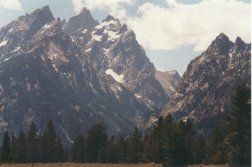 |
|
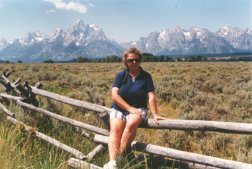 |
|
<<< Wednesday, 31 July - Sunday, 4th August 1996
Following a lot of questioning, monitoring of the RV forum,
visits to seminars and stands at rallies, George decided to have a
high-performance air intake and exhaust system fitted to the RV. This should
improve performance when ascending the many mountain ranges on the west coast
and Canada as well as reducing any risk of overheating. The owner of the company
which fitted the exhaust system invited us to camp at his home in
Jackson, which has a beautiful location facing the
Great Teton mountain range. It was a bit like staying on a small farm with cows,
pigs, sheep, horses etc. wandering about, but fortunately without any of the
normal farm smells or mess.
While the exhaust was being fitted we explored part of
the Teton mountain range, which rises to 13,700 feet
and has glaciers on many higher slopes. The Tetons rise almost vertically from a
very wide flat valley, which makes the mountains look even more dramatic. The
mountains provide an ideal winter recreation location for skiers and snowmobiles
are used extensively. We watched several moose feeding along the river banks and
my, are they big, it would not do to get in their way.
 |
 |
|
 |
|
We took a day trip into Idaho
(Famous Potatoes) to see Idaho Falls, however, whilst the falls were mildly
interesting being some 100 yards wide but the drop was only 10 feet, the town
itself was very industrial and had little else to offer.
All of Sunday was spent washing and polishing the car and RV which can be a waste of time as it is so dusty that everything becomes dirty again in no time.
Left Jackson on the 89 heading south and found that
the road closely followed the Snake river through dramatic valleys and canyons
for over 100 miles. We had heard about rivers that can stop flowing for some
time and then restart, well at a rest stop we found one that regularly stops
flowing for anywhere between 3 and 30 minutes and then starts flowing again. It
seems that the river flows into a cave within the mountain and when the cave is
full, the water rises through a tunnel in the cave roof and then via a siphon
action, the water flows out into the valley sucking out most of the water in the
cave. Once the level drops in the cave below the tunnel the siphon action stops,
and the river runs dry while the cave refills - fascinating.
The road then went along the side of
Bear Lake for about 25 miles, which was notable for its very deep
blue colour. After 200 miles of very enjoyable scenery, we joined the I84 and
were quickly brought back to civilisation by the heavy traffic and the urban
sprawl of Salt Lake City. At the far end of
Salt Lake valley, a fire was ranging on a mountainside and the smoke was
drifting for miles. After travelling for 380 miles we stopped for the night
about 20 miles south of Springville at a
mountain truck stop, but it was noisy and dirty.
Wednesday, 7 & Thursday, 8 August 1996
|
After a disturbed night due to trains all with at
least 100 coal wagons passing at regular intervals throughout the night,
we continued south on route 6 through a long canyon which climbed to
7,000 feet and then descended into a plain with similar but less
dramatic characteristics to the South Dakota Badlands. We decided to
stop at Moab, Utah (As Nice As Ever) for two
days as it is an area renowned for outstanding rock formations. It
became clear very quickly that we needed to stay for at least a week to
do the area justice, but can only stay one and a half days as we must
soon be 500 miles to the south for our flight home. During the afternoon Valerie drove the 4X4 into the
Canyons National Park,
turning left into the Shafer Trail,
but stopping in horror after about 400 yards. The track which was barely
wider than the car was carved out of the mountainside with a vertical
drop of 1,500 feet on one side and a shear 500-foot or so vertical wall
on the other. This was only part of the problem as the very bumpy track
wound in a torturous fashion around the face of vertical rock for about
a mile and then descended via numerous hairpins to the valley floor.
Even George admitted afterwards that it was more than challenging! The
Shafer Trail was originally a cattle trail, then in the 1950's a track
for uranium hunters, but today it is a favourite 4X4 trail. We then
moved on to see various locations and spectacular views of multicoloured
mountains and rock formations. Iron oxide makes the predominately colour
red but the Colorado and Green rivers give a dramatic contrast. Anybody visiting
Utah must visit the
Moab area as it is fairly
central to many of the vast canyons and National parks. We only had time
to visit a few parks including the
Arches National Park, which is resplendent with not only
magnificent canyons, cliffs and spires but has numerous natural stone
arches ranging from a few feet high to some that tower over 45 feet. Due
to the heat (98F) we were only able to walk to some of the arches but it
was possible to see most of the large arches from the road. In the
evening we drove into Castle Valley
which is aptly named as many of the huge rock formations are castle-like
in shape and after 17 miles of inspiring but baron rock, a green valley
suddenly appears in the middle of nowhere. The whole canyon area
stretches for hundreds of miles in all directions, with virtually no
habitation or sign of life. Having had a lot of success in getting connected to
CompuServe during the past few weeks it was predictable when Barbara
specially asked us to log on around this period we could not find a
phone in Moab which would work. Eventually found one after trying
numerous phones in various locations the quality of the pay phone is
part of the problem but the quality of the local lines is a contributing
factor. |
 |
|
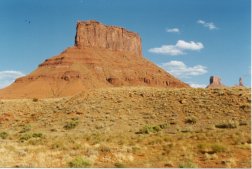 |
||
 |
||
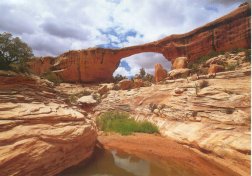 |
||
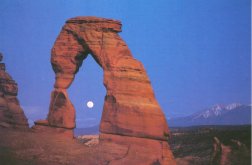 |
Friday, 9 August 1996
We left
Moab
with considerable regret but we decided to return in the spring of 1997. After
leaving the campground at 8.00 am we went directly to the local Quicklube where
they (without an appointment) immediately carried out a 3,000-mile service in
about 15 minutes which included an oil and filter change, all for $28 - good
value and service.
We took the 191 south out of
Moab and then the 163 which led us through
Monument Valley which is another staggering
area for dramatic rock formations. At the risk of boring all and sundry, it is
difficult to describe the impact these massive areas of rock formations have on
one. The area is vast, absolutely quiet, rarely it rains and has a range of
vivid colours but mainly with a strong dark red bias. The road then goes through
the Navajo Indian Reservation for
about 75 miles, but it seems the Indians have a hard time eking out a living in
an area with very few natural resources. Large parts of the reservation are no
more than collections of scrap automobiles and flimsy wooden structures from
where Indian jewellery is sold to passing tourists. We stopped for the night at
Tuba City which does not appear to have anything
going for it. A fact which typifies the poverty of the area is that a bale of
locally grown hay costs $9 whereas on the east coast it is $1.50 (bet you did
not know that!)
Saturday, 10 - Wednesday, 14 August 1996
Continuing south, we stopped for two nights in
Flagstaff, Arizona (Great Canyon State) but spent
most of the time spring cleaning the RV and car in readiness for their three
months of storage in Phoenix. Both the car and the RV were filthy but as
unfortunately many campgrounds do not allow washing, we had to go to the car
wash where we found that the front of the car had been badly chipped in numerous
places, which must have happened when we went through 23 (yes 23) miles of road
works the previous day. It was disappointing as it is the first time we had
sustained any damage.
Our campground had won an award as the best campground for
1995 and it was good, but we have never been anywhere before with so many rules
and notices about rules. Next to every notice displaying rules, there would be
another notice with even more rules.
We arrived in Phoenix on the 12th only to find that they are having
record temperatures, it reached 112F today and tonight it is not expected to go
below 90F. When we go outside it is just like walking into a furnace, even the
water coming out of the cold tap is hot enough to have a bath without any extra
heating. It appears that our tactics of touring the northern states for the past
three months have worked very well as in the main we have had very acceptable
temperatures. We are told that when we return to Phoenix in November
temperatures will be much more acceptable without any risk of freezing which
could have been the case if we had stored the RV in Wyoming.
Organised storage for the RV and car in an RV storage
compound ($168 for three months) which has secure fences and gates where the
owner lives in. As previously when we put the RV into storage we feel a little
nervous but have tried to minimise the risk as much as possible and it was good
to hear that our current campground owner gave the storage company a good
report.